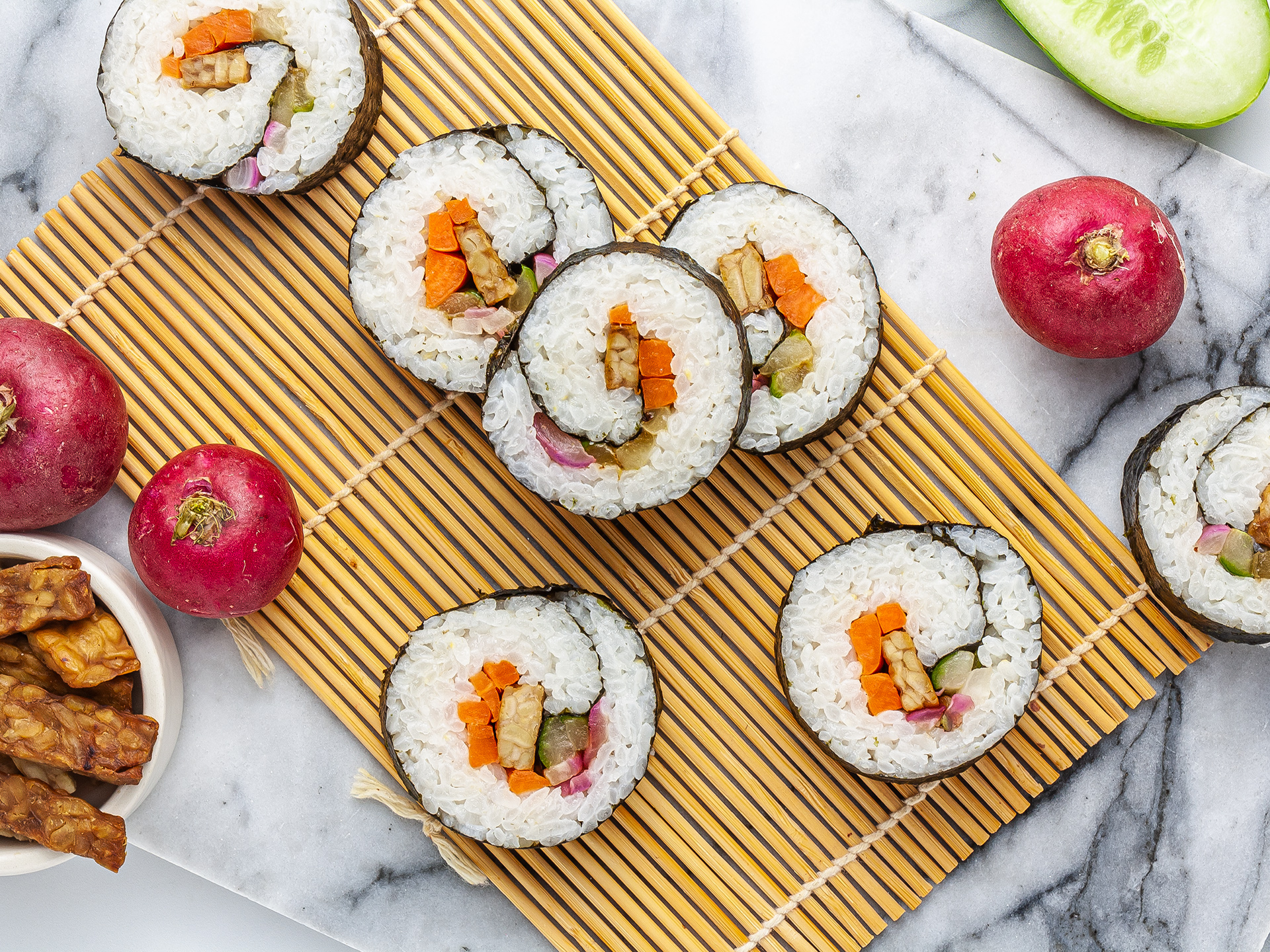If the thought of sushi night gets you excited, and you never say no to trying new sushi makis, then rejoice! There's a whole family of Korean rice rolls waiting for you, known as kimbab or gimbab. We are thrilled as well, as today we will show you how to make vegan kimbab at home.
Kimbab is colloquially referred to as "Korean sushi" because, just like the Japanese sushi maki, it also uses a base of white rice wrapped in seaweed. They are a delectable and practical snack enjoyed by busy people on-the-go or savoured with gusto before the main course.
In theory, sushi means "made with vinegared rice", but kimbab doesn't use rice vinegar in the process. As such, calling kimbab "sushi" is not accurate, but it makes the point quite well, so we will stick with it here. Instead of vinegar, Korean rice rolls use sesame oil.
The other big difference lies in the ingredients used to fill the rice rolls. While traditional sushi is famous for using raw fish, kimbab makes heavy use of pickled vegetables and cooked ingredients, like canned tuna, grilled meat or even cheese.
We propose a tasty alternative to the many kimbab recipes. Our recipe is vegan, and we used common ingredients so that you can prepare these bite-sized snacks even without a Korean grocery nearby. We filled our vegan kimbab with grilled carrots, cucumber, radish and tempeh. Easy right?
If you have never tried tempeh before, think of it like tofu, just more nutritious and tastier. The difference is that tofu comes from soy milk, while tempeh is the product of fermented soybeans.
Fermented foods are incredibly healthy and nutritious, and tempeh is not an exception. When comparing their nutritional values, tempeh beats tofu on all fronts, except for calcium [1]. Moreover, tempeh has a nuttier and more prominent flavour than tofu. This bolder taste helps it stand out from the other veggies, making tempeh the better choice for our vegan recipe.
So are you ready to make some homemade kimbab? We promise it's going to be an easy and fun recipe. Let's go!
NOTE: The default ingredients yield 16 rice rolls and one serving consists of four kibmap.
Are sushi and kimbab the same?
Although Japanese sushi and Korean kimbab look similar at first, there are a few difference in the ingredients and method used to make the two rice rolls.
Their shape is similar, as they both consist of white rice (sushi rice) wrapped in seaweed and filled with various ingredients.
The first difference between sushi and kimbab is in the rice seasoning. After steaming and cooling the sushi rice, Japanese sushi calls for the use of rice vinegar, while Kimbab makes use of sesame oil.
The second difference is in the "filling" used in the two Asian rice rolls. Sushi is famous for its delicate raw fish that melts in our mouths. Kimbab instead uses a combination of pickled vegetables, grilled meat and fish, cheese, or even canned fish like tuna. The result is a more accessible snack that bursts with energizing and diverse flavours.
Sushi vs Kimbab: which one is healthier?
You may be wondering which one is the healthier snack between kimbab and sushi. Because both rice rolls come in many variations, it would be hard to make a general comparison. To answer this burning question, we will first look at the ingredients that form the base for both and then compare the ingredients used in traditional sushi maki against the most-common kimbab.
As we said above, both dishes use seaweed and white rice but use different seasoning.
White rice is not the healthiest type of rice. It is still a healthy food and has many good uses in diets, but that snowy appearance is the result of heavy processing which stripped the rice of most fibres, vitamins and minerals. Brown rice would be the better choice for healthier sushi and kimbab. But as both recipes use sticky white rice, so far it's a draw: Sushi 1 - Kimbab 1.
Contrary to white rice, dry seaweed is rich in nutrients. Both Korean and Sushi rolls use it, although the Korean nori is called gim and is seasoned with sesame oil. Nori has lots of antioxidants and is rich in iodine, which plays a critical role in the proper functioning of the thyroid. Because the Korean nori has added sesame oil, which is rich in healthy fats, gim takes the lead over plain nori. Sushi 1 - Kimbab 2.
The next question to address is: is it healthier to season rice with sesame oil or rice vinegar?
Sesame oil is rich with heart-healthy fats, loaded with powerful antioxidants sesamol and sesaminol, which research shows can protect heart cells from damage [2]. Moreover, early research on sesame oil found that it has strong anti-inflammatory properties [3].
Rice vinegar is a flavourful seasoning with almost zero carbs and, like other kinds of vinegar, it can help reduce blood sugar levels [4].
Overall, it seems sesame oil is more impressive than rice vinegar, but this may boil down to your diet. Are you after healthy fats? Sesame oil wins. Or do you prefer a seasoning with zero carbs for your weight-loss diet? Then go for rice vinegar. Let's call it a draw on this one: Sushi 2 - Kimbab 3.
If we don't take rice roll fillings into account, Kimbab is healthier than sushi because it boasts more nutrients and healthy fats.
But what about rice rolls with filling? Let's compare a salmon avocado maki with a tuna kimbab.
Salmon and avocado are kings in a wholesome diet. Together they deliver a potent mix of omega-3 fats, vitamins, and proteins: it's tough to beat them.
The ingredients used in tuna kimbab are canned tuna, pickled radish, other veggies like carrots and spinach, and mayo.
As you can see, this classic kimbab recipe is more complicated. Although the ingredients therein have many health benefits (except for mayo), we feel they can't win against the simplicity and wholesomeness of salmon and avocado. So classic maki wins against traditional kimbab: Sushi 3 - Kimbab 3.
To conclude, we found that all else being equal - that is, if we were to use the same fillings for both sushi and kimbab - the Korean rice roll is healthier than sushi because it has more healthy fats and nutrients. But traditional sushi rolls make up for this with more wholesome fillings.
If you are after a healthy Korean rice roll, look no further than our vegan kimbab recipe above.
How long can I keep Korean "sushi" in the fridge?
Because Kimbab uses cooked ingredients, it keeps longer in the fridge compared to sushi made with raw fish. Moreover, our kimbab recipe above uses only vegetables, which have a longer shelf-life than animal products once cooked.
You can store excess vegan Korean rice rolls in an air-tight container and refrigerate for up to 5 days. However, the longer you keep them in the fridge, the dryer the rice will get. Therefore, if you want to prepare kimbap in advance, we recommend you refrigerate the unsliced nori roll well wrapped and then only cut the rice rolls when you are ready to eat them.
To eat, just take out of the fridge and enjoy them cold. Do not reheat the rolls in microwave, as the rice and seaweed will get soggy.
Is kimbab good for weight loss?
As our recipe includes little sesame oil and grilled vegetables, one kimbap rice roll has only 50 calories, meaning you can enjoy one or two of these snacks without compromising your weight loss goals.
You can also make a light meal out of it by adding a side a salad of leafy greens and nuts. As a serving, we suggest four sushi pieces which provide 200 calories and only 11% of your recommended daily intake (RDI) for carbohydrates and 7% of your RDI for fats.
By making these Korean rice rolls at home from scratch, you'll have complete control over the type and amount of ingredients and thus control over the calories.
Steamed white rice is a much healthier way of cooking rice compared to fried rice, making a better choice over other dishes. If you really want to go the extra mile, then you can swap white rice with other alternatives like quinoa, bulgur wheat, or brown rice for a healthier nutritional profile. Carrots, cucumber, and radishes are low-carb vegetables, while tempeh and nori are incredibly nutritious ingredients as they provide fibres, proteins, and precious minerals.
As with everything in life, moderation is key. So, as long as you're meeting your calorie goals, you can savour one or two of these bite-sized treats without guilt.
Ingredients
| Kimbap Filling | |
| Tempeh | 40 g |
| Carrots | 1 |
| Radishes | 3 |
| Cucumber | 1/2 |
| Kimbap Rice | |
| Short-Grain Sushi Rice | 175 g |
| Water | 260 mL |
| Sesame Oil | 1 tbsp |
| Salt | to taste |
| Others | |
| Nori Sheets | 2 |
Step 1
To remove excess starch, rinse the short-grain rice three times or until the drained water is clear.
Allow the rice to drain for 15 minutes on a colander before adding it to a deep pot with the water.
Bring to a boil and cook covered for 10 minutes without lifting the lid or stirring the rice.
Once the water has evaporated, remove the pan from the heat and, while keeping the lid on, allow the rice to finish cooking in its steam for further 15 minutes.
After this time, transfer the sticky rice onto a large plate, fluff it with a wooden spoon to speed up the cooling time, and season it with sesame oil and salt.
Don't allow the rice to cool down completely, as it will be easier to work when it's slightly warm.
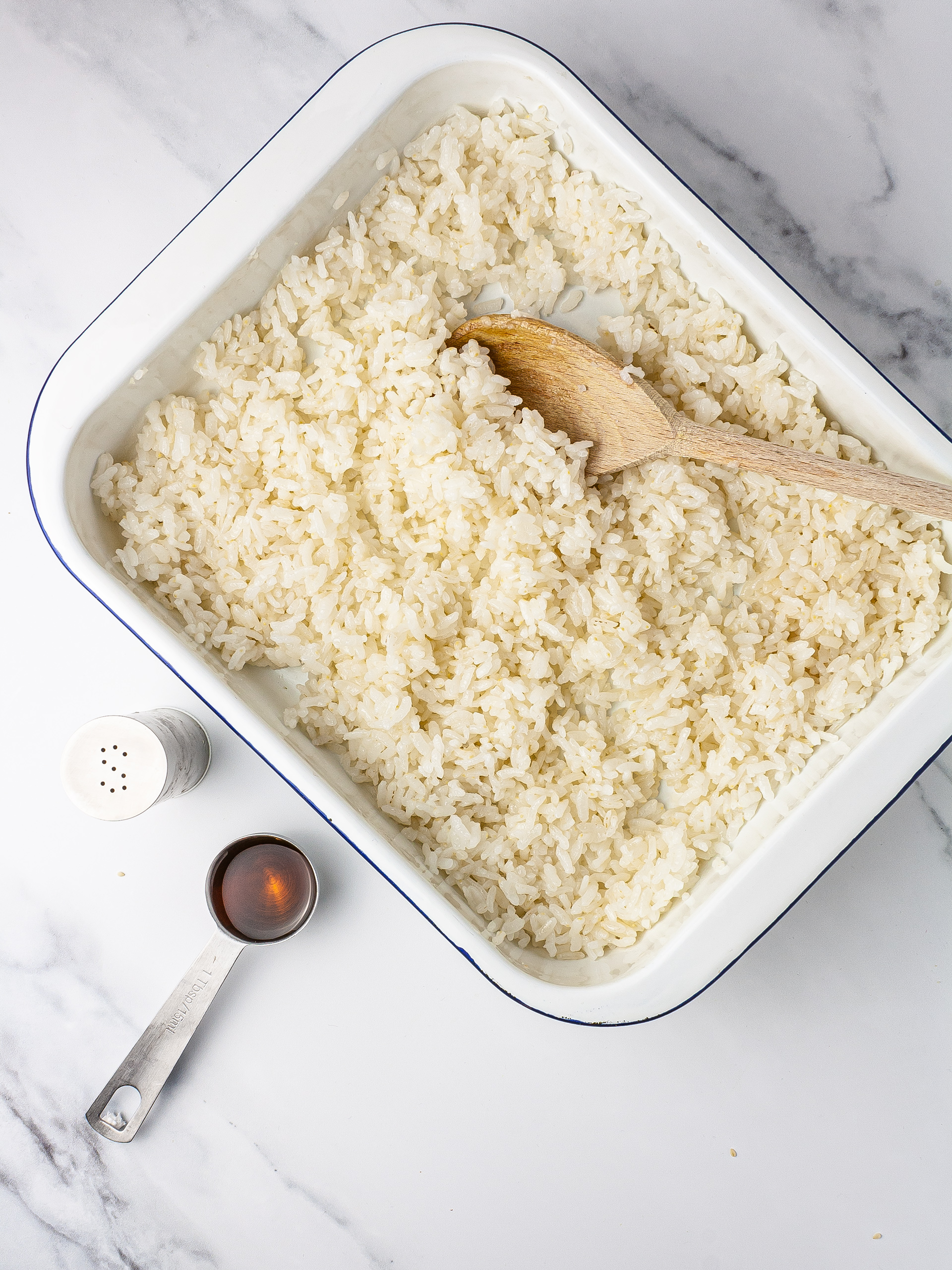
Step 2
In the meantime, let's prepare with kibamp fillings.
Pat the tempeh dry and slice it into strips. Then, julienne the carrots and the cucumber, and cut the radishes into small chunks (1).
Heat a grilling pan and roast the vegetables and tempeh until they are nicely browned and season them with salt to taste (2).
If you don't have a grilling pan, you can just pan-fry the stuffing ingredients or also roast them in the oven.
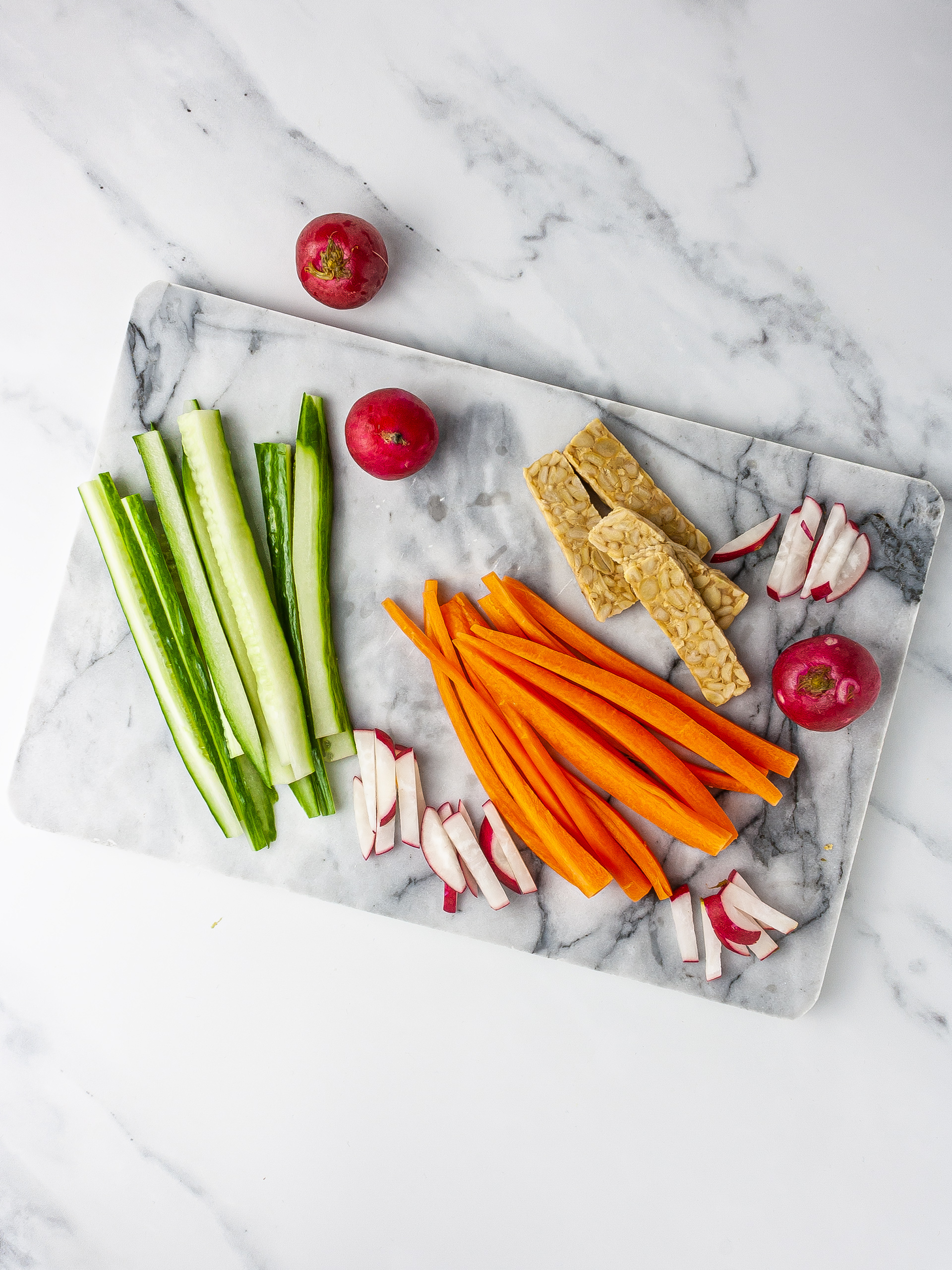
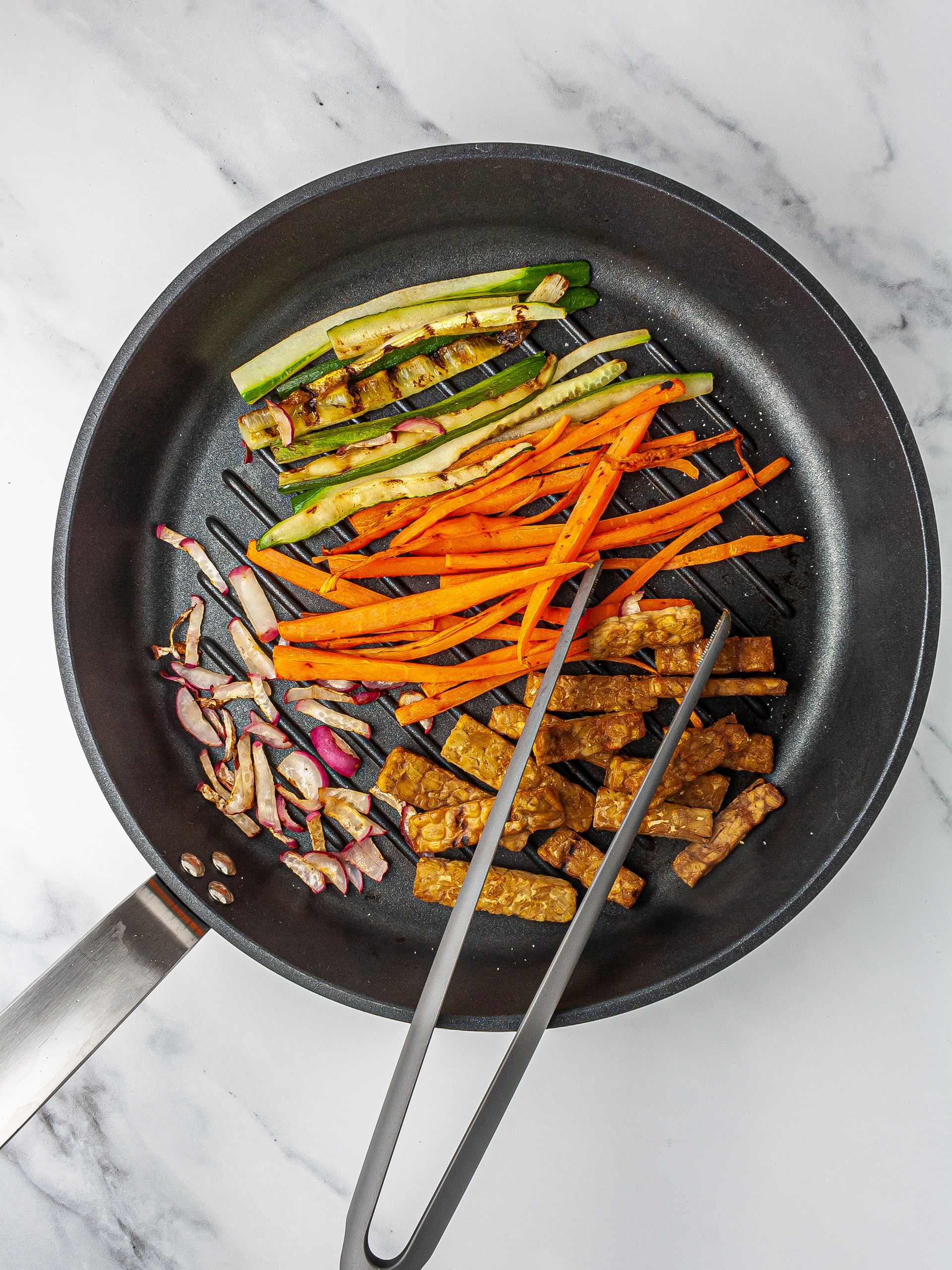
Step 3
Now, it's time to assemble our rice rolls.
On a sushi mat, lay one nori sheet and spread a few handfuls of prepared sticky rice evenly, patting it down with moistened fingers. Leave the 2.5 cm (1 inch) at the top edge of the seaweed bare.
Place the stuffing ingredients in adjacent rows, starting with the tempeh strips at 2.5 cm (1 inch) from the bottom of the rice (1).
Roll the kimbap from the bottom, wrapping the fillings and gently pressing down as you roll.
Seal the top edge of the nori sheet running a wet finger along the seam.
Next, wet a sharp knife with a damp cloth and slice the seaweed rice roll into eight pieces (2).
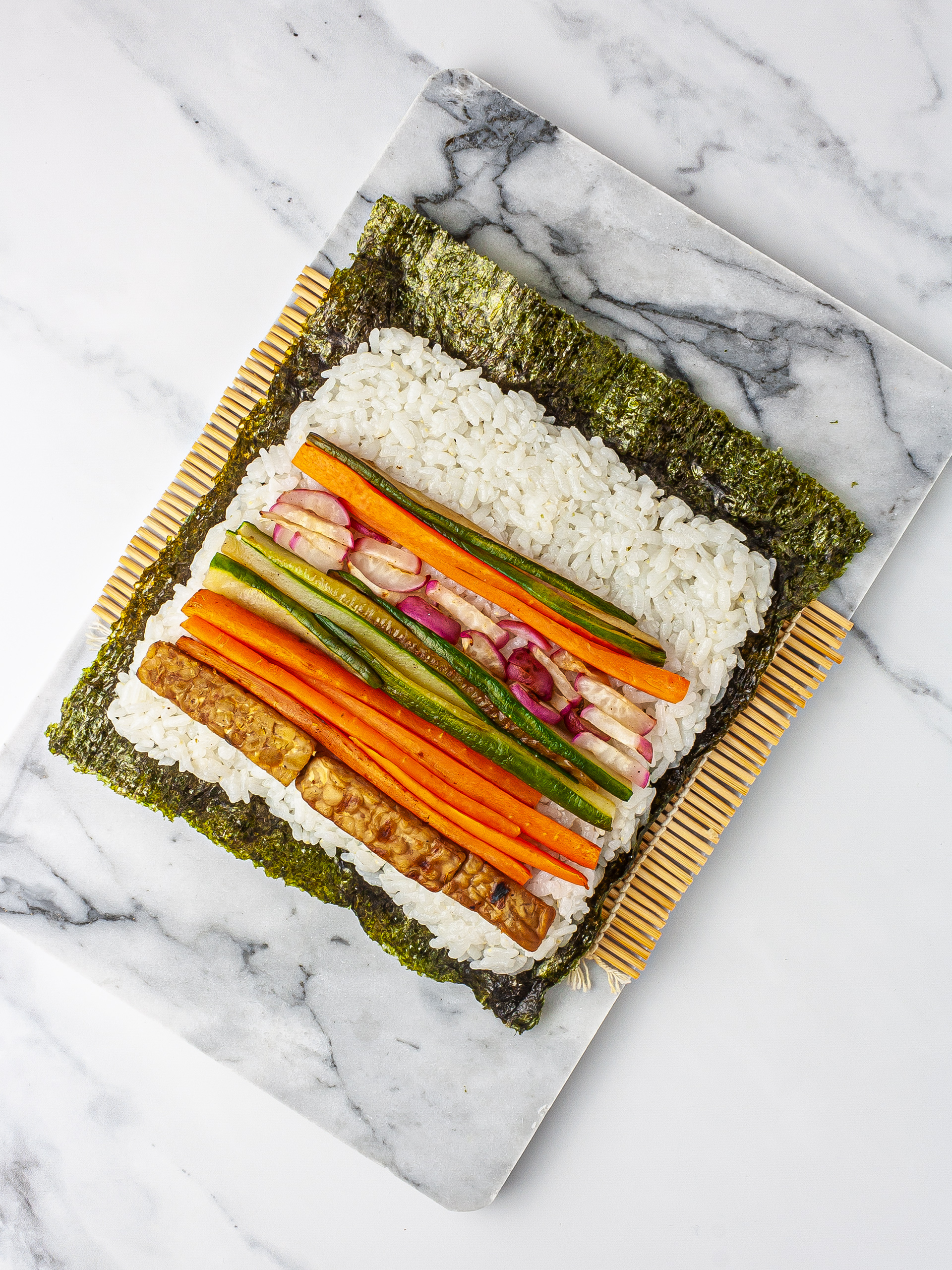
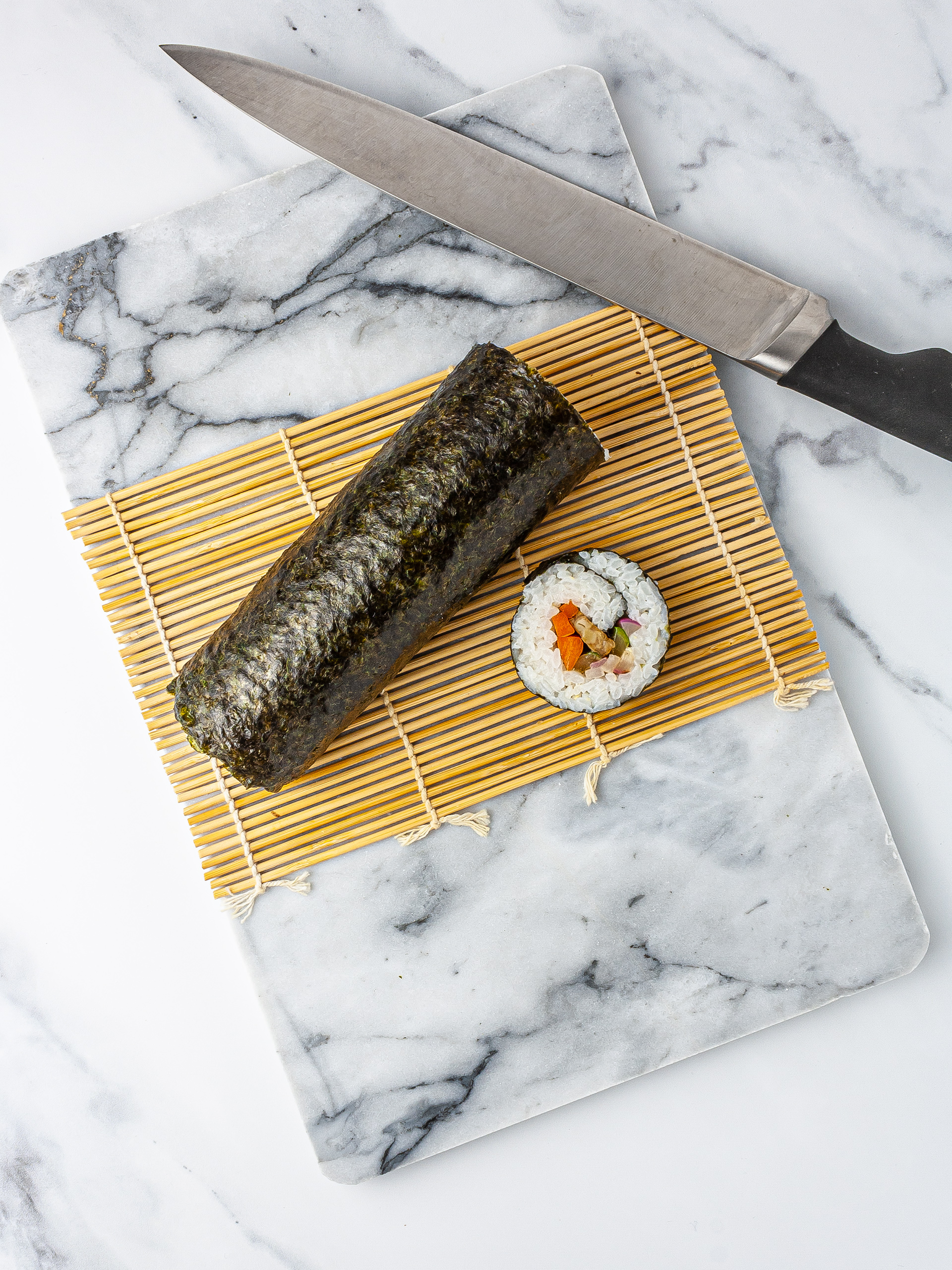
Tips
For extra flavour, rub the nori sheet with sesame oil before spreading the sushi rice and rolling into kimbap pieces.
